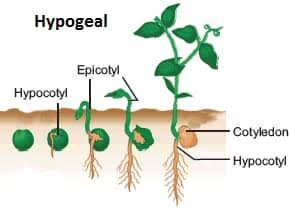What Is Epigeal Germination?

Epigeal germination is a process of germination in which the cotyledons emerge out of the soil due to the elongation action of the hypocotyl. The hypocotyl is generally the part of the stem of an embryo plant beneath the stalks of the seed leaves or cotyledons and directly above the root. Elongation of the hypocotyl in the longitudinal direction lifts the growing tip (usually including the seed coat) above the ground, bearing the embryonic leaves referred to as cotyledons and the plumule that gives rise to the first true leaves.
Plants that show epigeal germination grow relatively fast, especially in the first phase when the leaflets unfold. Epigeal germination occurs in:
- Castor
- Cotton
- Papaya
- Beans
- Lily
- Peas
- Plums
- Peaches
Characteristics Of Epigeal Germination
- In Epigeal germination, the seed leaves or the cotyledons emerge onto the surface or above the soil along with the shoot.
- Epigeal germination is generally common in dicots seeds e.g beans, castor,
- In this type of germination, the terminal part of the hypocotyl is curved to protect the plumule from friction of the soil.
- The cotyledons emerge out of the soil due to excessive growth of the hypocotyl.
- The plumule comes out of the seed coat by the elongation of the hypocotyl.
- The energy for growth in epigeal germination is mainly derived from the cotyledon.
- In this type of germination, the cotyledons turn green, act as the first leaves of the plant and take part in photosynthesis.
- The plumule remains enclosed and protected by cotyledons till it comes out of the soil.
- The epicotyl is generally short in plants that show epigeal germination.
What Is Hypogeal Germination?

Hypogeal germination is a type of germination whereby cotyledons or the seed leaves do not emerge on the surface, they just remain underground. This is usually due to the rapid development and elongation of the epicotyl. The epicotyl is generally the embryonic shoot above the cotyledons. Development and elongation of the epicotyl pushes the plumule out of the soil, an action that causes the cotyledons to remain below the soil surface. In most plants the epicotyl will eventually develop into the leaves of the plant.
Hypogeal germination occurs in:
- Arum
- Pea
- Water lily
- Maize
- Wheat
- Orchid
- Tulips
- Palm
Characteristics Of Hypogeal Germination
- In Hypogeal germination, the cotyledons or the seed leaves do not emerge on the surface, they just remain underground.
- Hypogeal germination is generally common in monocot seeds e.g coconut, maize, water lily, arum and pea.
- In this type of germination, the terminal part of the epicotyl is curved in order to reduce damage to plumule by friction from soil particles.
- In this type of germination, the hypocotyl elongates slightly and the epicotyl grows and takes the plumule above the soil.
- The plumule comes out of the seed coat by the elongation of epicotyl.
- The energy for growth in hypogeal germination is mainly derived from the endosperm.
- In this type of germination, the cotyledons do not play any role in photosynthesis.
- The plumule does not remain enclosed and protected by cotyledons till it comes out of the soil.
- The epicotyl is long in plants that show hypogeal germination.
Difference Between Epigeal And Hypogeal Germination In Tabular Form
| BASIS OF COMPARISON
| EPIGEAL GERMINATION | HYPOGEAL GERMINATION |
| Cotyledons | The seed leaves or the cotyledons emerge onto the surface or above the soil along with the shoot. | The cotyledons or the seed leaves do not emerge on the surface, they just remain underground. |
| Presence | Epigeal germination is generally common in dicots seeds e.g beans, castor. | Hypogeal germination is generally common in monocot seeds e.g coconut, maize, water lily, arum and pea. |
| The Terminal Part | The terminal part of the hypocotyl is curved to protect the plumule from friction of the soil. | The terminal part of the epicotyl is curved in order to reduce damage to plumule by friction from soil particles. |
| Cotyledons/Plumule Emergence Out Of Spoil | The cotyledons emerge out of the soil due to excessive growth of the hypocotyl. | The hypocotyl elongates slightly and the epicotyl grows and takes the plumule above the soil. |
| Plumule | The plumule comes out of the seed coat by the elongation of the hypocotyl. | The plumule comes out of the seed coat by the elongation of epicotyl. |
| Energy Used During Germination | The energy for growth in Epigeal germination is mainly derived from the cotyledon. | The energy for growth in hypogeal germination is mainly derived from the endosperm. |
| Cotyledons & Photosynthesis | The cotyledons turn green, act as the first leaves of the plant and take part in photosynthesis. | The cotyledons do not play any role in photosynthesis.
|
| Plumule | The plumule remains enclosed and protected by cotyledons till it comes out of the soil. | The plumule does not remain enclosed and protected by cotyledons till it comes out of the soil. |
| Epicotyl | The epicotyl is generally short in plants that show epigeal germination. | The epicotyl is long in plants that show hypogeal germination. |